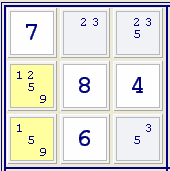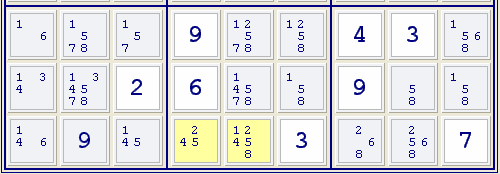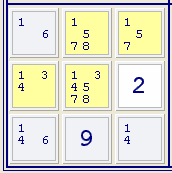
Any cells which have only one candidate can safely be assigned that value.
It is very important whenever a value is assigned to a cell, that this value is also excluded as a candidate from all other blank cells sharing the same row, column and box.

Very frequently, there is only one candidate for a given row, column or box, but it is hidden among other candidates.
In the example on the right, the candidate 6 is only found in the middle right cell of the 3x3 box. Since every box must have a 6, this cell must be that 6.

If two cells in a group contain a pair of candidates (hidden amongst other candidates) that are not found in any other cells in that group, then other candidates in those two cells can be excluded safely.
In the example on the right, the candidates 1 & 9 are only located in two highlighted cells of a box, and therefore form a 'hidden' pair. All candidates except 1 & 9 can safely be excluded from these two cells as one cell must be the 1 while the other must be the 9.
If three candidates are restricted to three cells in a given group, then all other candidates in those three cells can be excluded.
In the example below, the candidates 3, 6 and 7 are found only in column four, six and seven. Therefore, all other candidates can be excluded from those three cells.
Hidden triples are generally extremely hard to spot but fortunately they're rarely required to solve a puzzle.

If four candidates are restricted to four cells in a given group, then all other candidates in those four cells can be excluded.
Hidden Quads are very rare, which is fortunate since they're almost impossible to spot even when you know they're there.

Locked Candidates 1
Sometimes a candidate within a box is restricted to one row or column. Since one of these cells must contain that specific candidate, the candidate can safely be excluded from the remaining cells in that row or column outside of the box.
In the example below, the right box only has candidate 2's in its bottom row. Since, one of those cells must be a 2, no cells in that row outside that box can be a 2. Therefore 2 can be excluded as a candidate from the highlighted cells.


Sometimes a candidate within a row or column is restricted to one box. Since one of these cells must contain that specific candidate, the candidate can safely be excluded from the remaining cells in the box.
In the example on the right, the left column has candidate 9's only in the middle box. Therefore, since one of these cells must be a 9 (otherwise the column would be without a 9), 9's can safely be excluded from all cells in this middle box except those in the left column.
If two cells in a group contain an identical pair of candidates and only those two candidates, then no other cells in that group could be those values.
These 2 candidates can be excluded from other cells in the group.
In the example below, the candidates 6 & 8 in columns six and seven form a Naked Pair within the row. Therefore, since one of these cells must be the 6 and the other must be the 8, candidates 6 & 8 can be excluded from all other cells in the row (in this case just the highlighted cell).


The same principle that applies to Naked Pairs applies to Naked Triples & Naked Quads.
A Naked Triple occurs when three cells in a group contain no candidates other that the same three candidates. The cells which make up a Naked Triple don't have to contain every candidate of the triple. If these candidates are found in other cells in the group they can be excluded.
In the example on the right, a Naked Triple is formed by the top left, bottom left & bottom right cells of a box since they only contain the candidates 1, 4 & 6. Therefore the candidates 1 & 4 in the highlighted cells can be excluded safely.

A Naked Quad occurs when four cells in a group contain no candidates other that the same four candidates.
In the example on the right, the candidates 2, 5, 7 & 9 in the 3 left most cells and bottom middle cell of a box form a Naked Quad. Therefore candidates 5 & 7 that are in the highlighted cells can be excluded.